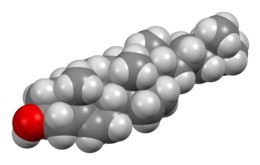**Cholesterol Synthesis and Physiology**:
– Cholesterol is synthesized mainly by hepatocytes and transported in the blood to peripheral cells.
– De novo synthesis involves a 37-step process starting with the mevalonate pathway.
– A human male weighing 68kg normally synthesizes about 1 gram of cholesterol per day.
– Most ingested cholesterol is esterified and poorly absorbed by the gut.
– Brain cholesterol is produced and distributed by astrocytes, separate from peripheral cholesterol.
**Cholesterol Functions in Cell Membranes**:
– Cholesterol is present in all animal cell membranes, modulating fluidity and integrity.
– It interacts with water molecules and phospholipids, increasing membrane packing and reducing permeability.
– The tetracyclic ring structure contributes to membrane fluidity and shape change.
– Cholesterol reduces plasma membrane permeability to solutes and ions.
– Allows animal cells to move without rigid cell walls.
**Cholesterol in Signaling and Substrate Presentation**:
– Cholesterol aids in cell signaling processes by forming lipid rafts in the plasma membrane.
– Regulates substrate presentation and activates enzymes like phospholipase D2.
– Cholesterol affects the gating of ion channels and activates specific receptors.
– Plays a crucial role in substrate presentation mechanisms.
– Facilitates the speed of electrical impulse transmission along nerve tissue.
**Cholesterol as a Key Mediator and Chemical Precursor**:
– Inhibition of ERRα signaling affects bone, muscle, and macrophages.
– Statins and bisphosphonates impact cholesterol production.
– Cholesterol is a precursor for vitamin D, steroid hormones, and sex hormones.
– Influences calcium metabolism through vitamin D synthesis.
– Biochemical pathways rely on cholesterol as a precursor for various processes.
**Cholesterol in Epidermis and Calcium Metabolism**:
– Cholesterol, ceramides, and free fatty acids create a water-impermeable barrier in the epidermis.
– Vitamin D synthesis crucial for calcium metabolism.
– Cholesterol influences calcium metabolism through vitamin D synthesis.
– Stratum corneum comprises corneocytes within a lipid matrix.
– Cholesterol’s role in vitamin D synthesis impacts calcium homeostasis.
Cholesterol is the principal sterol of all higher animals, distributed in body tissues, especially the brain and spinal cord, and in animal fats and oils.

| |

| |

| |

| |
| Names | |
|---|---|
| IUPAC name
Cholest-5-en-3β-ol
| |
| Systematic IUPAC name
(1R,3aS,3bS,7S,9aR,9bS,11aR)-9a,11a-Dimethyl-1-[(2R)-6-methylheptan-2-yl]-2,3,3a,3b,4,6,7,8,9,9a,9b,10,11,11a-tetradecahydro-1H-cyclopenta[a]phenanthren-7-ol | |
| Other names
Cholesterin, Cholesteryl alcohol
| |
| Identifiers | |
3D model (JSmol)
|
|
| ChEBI | |
| ChEMBL | |
| ChemSpider | |
| ECHA InfoCard | 100.000.321 |
| KEGG | |
PubChem CID
|
|
| UNII | |
CompTox Dashboard (EPA)
|
|
| |
| |
| Properties | |
| C27H46O | |
| Molar mass | 386.65 g/mol |
| Appearance | white crystalline powder |
| Density | 1.052 g/cm3 |
| Melting point | 148 to 150 °C (298 to 302 °F; 421 to 423 K) |
| Boiling point | 360 °C (680 °F; 633 K) (decomposes) |
| 0.095 mg/L (30 °C) | |
| Solubility | soluble in acetone, benzene, chloroform, ethanol, ether, hexane, isopropyl myristate, methanol |
| -284.2·10−6 cm3/mol | |
| Hazards | |
| Flash point | 209.3 ±12.4 °C |
Except where otherwise noted, data are given for materials in their standard state (at 25 °C [77 °F], 100 kPa).
| |
Cholesterol is biosynthesized by all animal cells and is an essential structural component of animal cell membranes. In vertebrates, hepatic cells typically produce the greatest amounts. In the brain, astrocytes produce cholesterol and transport it to neurons. It is absent among prokaryotes (bacteria and archaea), although there are some exceptions, such as Mycoplasma, which require cholesterol for growth. Cholesterol also serves as a precursor for the biosynthesis of steroid hormones, bile acid and vitamin D.
Elevated levels of cholesterol in the blood, especially when bound to low-density lipoprotein (LDL, often referred to as "bad cholesterol"), may increase the risk of cardiovascular disease.
François Poulletier de la Salle first identified cholesterol in solid form in gallstones in 1769. In 1815, chemist Michel Eugène Chevreul named the compound "cholesterine".
